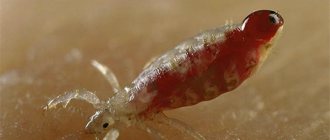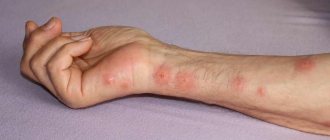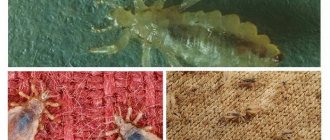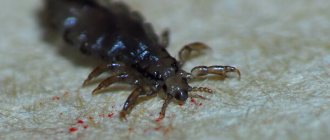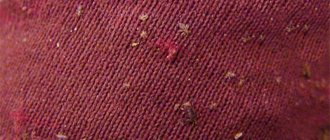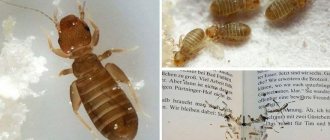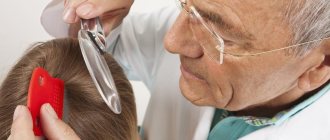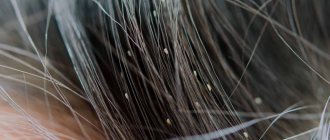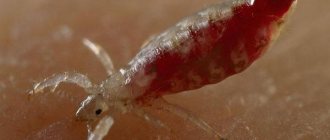Insect order
"Lice" redirects here. For infection, see Pediculosis. For the area of Diyarbakir Province in Turkey, see Lice, Türkiye. For other uses, see Louse (disambiguation).
| Phthiraptera Temporal range: Eocene – present PreꞒ Page N | |
| Light micrograph of Fahrenholzia pinnata | |
| Scientific classification | |
| Kingdom: | Animalia |
| Type: | Arthropods |
| Class: | Insect |
| Super order: | Psocodea |
| Order: | Phthiraptera Haeckel, 1896 |
| Sub-orders | |
| Anoplura Rincoftirina Ischnocera Amblycera | |
Louse
(plural:
lice
) is the common name for members of the order
Phthiraptera
, which contains about 5,000 species of wingless insects. Lice are obligate parasites that live externally on warm-blooded hosts which include all bird and mammal species except monotremes, pangolins, and bats. Lice can be vectors for diseases such as typhus.
Chewing lice live among the hair or feathers of their host and feed on skin and debris, while sucking lice pierce the host's skin and feed on blood and other secretions. They usually spend their entire lives on one host, holding together eggs called nits
, to hair or feathers. The eggs hatch into nymphs, which molt three times before they are fully grown, which takes about four weeks.
Humans are host to two species of lice: the head louse and the subspecies Pediculus humanus.
;
and the pubic louse, Ptyrus pubis
. The body louse has the smallest genome of any known insect; it has been used as a model organism and has been the subject of many studies.
Lice were ubiquitous in human society at least until middle age. They appear in fairy tales, songs such as the Kilkenny Lice House
, and novels such as James Joyce's
Finnegans Wake
.
They are commonly found in mental disorders. delusional parasitosis. The louse was one of the first subjects of microscopy, appearing in Robert Huck's 1667 book, Micrographia
.
Morphology and diversity
For information on human infestations, see Pediculosis. For treatment information, see Treatment of lice in humans.
Lice are divided into two groups: sucking lice, which feed on the sebaceous secretions and body fluids of the host; and chewing lice, which are scavengers by feeding on skin, fragments of feathers or hair, and debris found on the host's body. Many lice are specific to one host species and have evolved with it. In some cases, they live only on a specific part of the body. Some animals are known to harbor up to fifteen different species, although mammals typically have one to three, and birds two to six. Lice usually cannot survive long if they are removed from their host.[1] If their host dies, lice can use phoresis to fly around and try to find a new host.[2]
Sucking lice range in length from 0.5 to 5 mm (1⁄64 to 13⁄64 in). They have narrow heads and oval, flattened bodies. They lack an ocelli and their compound eyes are reduced in size or absent. Their antennae are short, with three to five segments, and their mouthparts, which retract into the head, are adapted for piercing and sucking.[3] At the beginning of the intestine is the cibarial pump; it is driven by muscles attached to the inside of the cuticle of the head. The oral apparatus consists of a toothed proboscis and a set of stylets located in a cylinder inside the proboscis containing a salivary canal (ventrally) and a feeding canal (dorsally).[4] The thoracic segments are fused, the abdominal segments are separate from each other, and there is a single large claw at the end of each of the six legs.[3]
Chewing lice also have a flattened shape and can be slightly larger than sucking lice, ranging from 0.5 to 6 mm (1⁄64 to 15⁄64 in). They are similar in shape to sucking lice, but the head is wider than the thorax, and all species have compound eyes. There are no eyes; the mouthparts are adapted for chewing. The antennae consist of three to five segments and are thin in the suborder. Ischnocera, but club-shaped in the suborder Amblycera. The legs are short and strong, ending in one or two claws. Some types of chewing house lice symbiotic bacteria into bacteriocytes in their bodies. They can help digestion because if an insect is deprived of them, it will die.
Lice are usually cryptically colored to match the fur or feathers of the host.[3][5] Lice range in color from pale beige to dark gray; however, if you feed on blood, it may become significantly darker.
Female lice are usually more common than male lice, and some species are parthenogenetic, with the young developing from unfertilized eggs. A louse egg is commonly called a nit. Many lice attach their eggs to the host's hair using special saliva; The connection between saliva and hair is very difficult to break without special products. However, lice that inhabit birds can simply leave their eggs in parts of the body that are inaccessible to them. preening, for example, the inside of feather shafts. Live lice eggs are usually pale whitish, while dead lice eggs are yellower.[1] Lice are exopterygotic, being born as miniature versions of an adult known as nymphs. The young molt three times before reaching their final adult form, usually within a month of hatching.[1]
Humans have three different types of lice: pediculosis lice, and pubic lice. Lice and head lice are subspecies of Pediculus humanus
, and pubic lice are a separate species,
Pthirus pubis
. Lice infestations can be controlled using lice combs and medicated shampoos or cleansers.[6]
Life cycle
The lifespan of lice is on average 38 days. 2-3 days after the last molt, the female begins to lay up to 4 eggs (called nits) per day, gluing them to her hair with an adhesive mass. In total, she is capable of laying up to 140 eggs during her short life. After 5-8 days, larvae appear and immediately begin to feed on blood. In 16 days, they manage to molt 3 times before they turn into adults, and then they can immediately begin to reproduce. An adult insect lives on average 27 days. Outside the host's body, it dies within a day.
Ecology
The average number of lice per host is generally higher in large bird species than in small ones.[7] Lice have an aggregated distribution among bird individuals, meaning most lice live on a few birds, while most birds are relatively lice-free. This pattern is more pronounced in territorial than in colonial - more social - bird species.[8]Hosts that dive underwater in search of aquatic prey contain fewer lice taxa.[9][10]Bird taxa that are able to provide more strong antiparasitic defenses, such as a stronger T-cell immune response or larger genitourinary glands, inhabit more taxa of Amblicerian lice than others.[11][12] Reductions in the size of host populations can cause long-term declines in lice taxonomic richness,[13] e.g. birds introduced to New Zealand there are fewer types of lice here than in Europe.[14][15] Lice sex ratios are more balanced in more social hosts and more female-biased in less social hosts, likely due to greater isolation among lice subpopulations (living on different birds) in the latter case.[16] The disappearance of a species leads to the disappearance of the lice that are its host. Host switching is a random event that can very rarely succeed, but speciation has occurred on evolutionary timescales so it must sometimes be accomplished successfully.[13]
Lice can shorten the host's lifespan if the infestation is severe,[17] but most appear to have little effect on the host. The habit of dust bathing in domestic chickens is probably an attempt by the birds to get rid of lice.[3] Lice can transmit microbial diseases and helminth parasites,[18] but most individuals spend their entire life cycle on a single host and may only move to a new host accidentally.[3] Ischnocerin lice may reduce the thermoregulatory effect of plumage; thus, heavily infested birds lose more heat than others.[19]Lice infestation is a disadvantage in the context of sexual competition.[20][21]
Head louse: description, structure, characteristics. What does a louse look like?
Lice are winged insects belonging to the genus Pediculus. The main habitat is the scalp (hair, mustache, beard). The scalp has a circular cross-section, which is ideal for insect legs.
Color – gray. After saturation with blood, the color of the body becomes red or purple. The length of males does not exceed 3 mm, and females - 4 mm. A female can live up to 1 month, laying up to 5 eggs per day. The maturation of eggs (nits) occurs near the base of the hair. The ripening period for nits is up to 10 days. After hatching, the louse is ready for fertilization within 10 days.
For the scalp, a temperature of about 28 °C is considered normal. This temperature regime is ideal for nit maturation. If the temperature drops by 5 °C, then the insect’s vital activity will decrease. If the temperature drops below 12 °C, the insect stops laying eggs, and when the temperature of the skin drops below 10 °C (after the death of a person), the insects begin to crawl away in search of food. Without fresh blood, an insect can live for 2-3 days. If the temperature rises above 35°C, the development of the insect slows down, and at a temperature of about 45°C it dies. However, lice are resistant to the lack of oxygen. They can live under water for up to 2 days.
The head louse is not a carrier of dangerous diseases. However, when insect saliva gets into the wound, severe itching appears. Constant scratching of the affected area causes irritation (lice). There is also a risk of infections entering the blood through damaged areas.
Evolution
Classification
The order Phthiraptera is clearly a monophyletic grouping, united by a number of derived characteristics, including their parasitism on warm-blooded vertebrates and the combination of their metathoracic ganglia with their ventral ganglia to form a single ventral nerve junction.[22] The order is traditionally divided into two suborders: sucking lice (Anoplura) and chewing lice (Mallophaga); however, recent classifications indicate that Mallophaga is paraphyletic and four suborders are now recognized:[23]
- Anoplura: sucking lice found exclusively in mammals
- Rhynchophthirina: parasites of elephants and warthogs
- Ischnocera: mostly avian chewing lice, but one family parasitizes mammals
- Amblycera: A primitive suborder of chewing lice, they are widespread in birds, but they are also found on mammals in South America and Australia.
About 5,000 species of lice have been identified, about 4,000 parasitize birds and 800 parasitize mammals. Lice are present on all continents in all habitats in which animals and birds live.[23] They can even be found in Antarctica, where penguins carry 15 species of lice (in the genus Austrogonoides
and
Nesiotinus
).[24]
The oldest known record of the Megamenopon Rasnitsini
is from the Eocene of Germany, but this is essentially a modern form belonging to Amblycera, so the group as a whole probably has a Mesozoic origin.[25]
- Ricinus bombycillae
, Amblicer louse from Bohemian waxwing
- Trinotone anserine
, Ambliceran louse from mute swan
- Damalinia limba
Ishnotceran louse from goat. The species is sexually dimorphic, with the male being smaller than the female.
Phylogeny
Lice were the subject of significant DNA research in the 2000s, which led to discoveries in the field of human evolution. The three species of sucking lice that parasitize humans belong to two genera: Pediculus
and
Pthirus
: pediculosis (
Pediculus humanus capitis
), lice (
Pediculus humanus humanus
) and pubic lice (
Pthirus pubis
).
Human head and body lice (genus Pediculus
) share a common ancestor with chimpanzee lice, and pubic lice (genus
Ptyrus
) share a common ancestor with gorillas.
Using phylogenetic and cophylogenetic analyses, Reed et al. suggested that Pediculus
and
Ptyrus
are sister taxa and monophyletic.[26]
In other words, the two genera descended from one common ancestor. The age of divergence between Pediculus
and its common ancestor is 6–7 million years ago, which matches the age predicted for the divergence of chimpanzees and hominids.[26] Because parasites rely on their hosts, cospeciation events between host and parasite are likely.
Genetic evidence suggests that human ancestors acquired pubic lice from gorilla approximately 3-4 million years ago.[26] Unlike the genus Pediculus
, the divergence at
Ptyrus
does not match the age of host divergence, which likely occurred 7 million years ago.
Reed et al. propose Ptyrus
as a species of switch hosts around 3–4 million years ago. Although it is difficult to determine whether parasite-host switching has occurred in evolutionary history, this explanation is the most parsimonious (containing the fewest evolutionary changes).[26]
Additionally, DNA differences between head lice and lice support that humans used clothing 80,000 to 170,000 years ago before leaving Africa.[27] Human head and body lice occupy separate ecological zones: head lice live and feed on the scalp, while body lice live on clothing and feed on the body. Because body lice require clothing to survive, distinguishing head and body lice from their common ancestor allows us to estimate the date of the appearance of clothing in human evolutionary history.[27][28]
Mitochondrial genome of the human species of taurus ( Pediculus humanus humanus
), the head louse (
Pediculus humanus capitis
) and the pubic louse (
Pthirus pubis
) fragmented into several minichromosomes at least seven million years ago.[29] Analysis of mitochondrial DNA from the human body and hair lice indicates that greater genetic diversity existed in African lice than in non-African lice.[28][30] Human lice may also shed light on human migration in prehistoric times. The dominant theory among anthropologists regarding human migration is the Out of Africa Hypothesis. Genetic diversity accumulates over time, and mutations occur at a relatively constant rate. Because African lice have more genetic diversity, lice and their human hosts must have existed in Africa earlier than anywhere else.[30]
The phylogeny of Phthiraptera is shown, but not yet fully resolved, in the cladogram:[31]
| Neoptera | |
| Eumetabola | |
| Paraneoptera | |
| Hemiptera | (errors) |
| Psocodea | |
| Troctomorpha | |
| Nanopsocetae | |
| Phthiraptera (lice) | |
In human culture
In social history
Drawing of a louse clinging to a human hair. Robert Hooke, Micrographia
, 1667
Lice have been closely associated with human society throughout history. in middle age, in fact, they were ubiquitous. At the death of Thomas Becket, Archbishop of Canterbury in 1170, it was recorded that "the vermin boiled like water in a boiling cauldron, and the onlookers burst into weeping and laughter."[32] Medieval treatment for lice was an ointment made from lard, frankincense, vesti, and aloe.[33]
Robert Huckbook 1667, Micrographia: Or, Some Physiological Descriptions of the Minute Bodies, Made with Magnifying Glasses, with Observations and Inquiries Thereon.
, illustrated a human louse depicted on an early microscope.[34]
Margaret Cavendish Satirical Description of a new world called the Burning World
(1668) has "lice men" as "mathematicians" exploring nature, trying to weigh the air like a real scientist. Robert Boyle.[35][36]
In 1935, Harvard medical researcher Hans Zinsser wrote the book Rats, Lice and History
, arguing that both body and head lice transmit typhus from person to person.[37]
Despite this, modern thinking is that only the body louse can transmit the disease.[38] Detail showing the removal from Jan Siberechts' painting Cour de ferme
("The Courtyard"), 1662
Soldiers in the trenches of World War I suffered greatly from lice, and they carried typhus. The Germans boasted that they had effective lice control, but they themselves suffered greatly from lice. World War II on the Eastern Front, especially the Battle of Stalingrad. "Unblocking" became a euphemism for the extermination of Jews in concentration camps such as Auschwitz under the Nazi regime.[39]
In the mental disorder delusional parasitosis, patients express a persistent irrational fear of animals such as lice and mites, imagining that they are constantly infested, and complain of itching, with “an unshakable false belief that living organisms are present in the skin.”[40]
In science
Human body lice Pediculus humanus humanus
has (2010) the smallest insect genome known.[41]
This louse can transmit certain diseases, while the human head louse ( P. h. capitis
), with which it is closely related, cannot. With their simple life history and small genomes, the pair is ideal. model organisms study the molecular mechanisms behind pathogen transmission and vector competence.[42]
In literature and folklore
The mother louse, the infamous Alewife in Oxford in the mid-18th century.
There are three lice on her crest. Image credit: David Loggan.[43][44] James Joybook 1939 Finnegans Wake
there is the character Shem Penman, infested with "foxtrotting fleas, bed lice, ... bats on his bell tower."[45]
Clifford E. Trafzer A Chemehuevi Song: The Resilience of a Southern Paiute Tribe
retells the story of Sinawawi (Coyote) love for Poovawi (Louse). Her eggs are sealed in a basket woven by her mother, who gives it to Coyote, telling him not to open it until he returns home. However, hearing voices coming from it, Coyote opens the basket and people, the first people in the world, pour out of it in all directions.[46]
Irish songwriter John Lyons (b. 1934) wrote the popular[47] song House of Lice Kilkenny
.
The song contains the lines: “Well, we went up the stairs and turned out the lights, Of course, in less than five minutes I had to show the fight. For the fleas and insects they collected they marched, And over my belly they formed a great arch." It was recorded by Christy Purcell (1952), Mary Delaney on From Puck to Appleby
(2003), and The Dubliners on
Double Dubliners
(1972) among others.[47][48]
Robert Burns dedicated a poem to the louse, inspired by seeing one on a woman's hat in church: "You ugly, nasty, damned winners, hated, shunned by saints and sinners, How dare you bait her, such a fair lady!" Go somewhere else and look for your lunch on some poor body." John Milton in Paradise Lost
referred to the biblical plague of lice that befell the pharaoh: “Frogs, lice and flies were to fill his whole palace with a hateful invasion and overrun the whole earth.”
John Ray recorded a Scottish proverb: “Give a beggar a bed and he will repay you with lice.” Shakespeare's Troilus and Cressida
, Thersites are compared by Menelaus, Agamemnon's brother, to a louse: “Ask me not what I should be if I were not Thersites; for I do not care to be a louse to Lazarus, therefore I was not Menelaus.”[49]
Nutrition
Lice feed on blood. Blood sucking occurs through the mouth opening on the insect's head. A piercing proboscis is used to pierce the skin and feed. After choosing a place, the insect presses the proboscis to the skin and cuts through the epidermis with a rotational movement of the cutting teeth of the terminal corolla.
The wound gradually deepens, which allows the insect to lower its proboscis into the dermal layers. Now bundles of flexible stylets extend from the proboscis, capable of moving in any direction inside the skin, which allows you to quickly find blood vessels. There are teeth on the stylets, with the help of which the walls of blood vessels are cut, after which the louse begins to feed.
An insect's stomach can hold up to 1 mg of blood. After entering the stomach, the blood does not clot, since the insect’s saliva contains anticoagulant substances. The louse can feed at any time of the day. The main condition is that the area chosen for food should be inactive.
Recommendations
- ^ a b c
Hoell, H.V.;
Doyen, J.T.; Purcell, A. H. (1998). Introduction to Insect Biology and Diversity
(2nd ed.). Oxford University Press. pp. 407–409. ISBN 978-0-19-510033-4. - University of Utah (2008). Ecology and evolution of transmission in feathered lice (Phthiraptera: Ischnocera)
. pp. 83–87. ISBN 978-0-549-46429-7. - ^ a b c d e
Capinera, John L. (2008).
Encyclopedia of Entomology
. Springer Science & Business Media. pp. 838–844. ISBN 978-1-4020-6242-1. - Gullan, P.J.; Cranston, P. S. (2014). Insects: An Essay on Entomology
. Wiley. pp. 41–42. ISBN 978-1-118-84615-5. - Smith, Vince. "Phthiraptera: Summary". Phthiraptera.info. Retrieved October 25, 2015.
- Mumcuoglu, Costa Y. (1999). "Prevention and treatment of pediculosis in children." Pediatric drugs
.
1
(3): 211–218. Doi:10.2165/00128072-199901030-00005. PMID 10937452. S2CID 13547569. - Rozha (1997). "Patterns of abundance of bird lice (Phthiraptera: Amblycera, Ischnocera)" (PDF). Journal of Avian Biology
.
28
(3):249–254. Doi:10.2307/3676976. JSTOR 3676976. - Rekasi J; and others. (1997). "Distribution patterns of bird lice (Phthiraptera: Amblycera, Ischnocera)" (PDF). Journal of Avian Biology
.
28
(2): 150–156. CiteSeerX 10.1.1.506.730. Doi:10.2307/3677308. JSTOR 3677308. - Felso B; and others. (2006). "Decreases in taxonomic diversity of lice (Insecta: Phthiraptera) in diving birds" (PDF). Journal of Parasitology
.
92
(4):867–869. Doi:10.1645/ge-849.1. PMID 16995408. S2CID 31000581. - Felso B; and others. (2007). "Diving behavior reduces the abundance of mammalian louse species (Insecta: Phthiraptera)" (PDF). Acta Parasitologica
.
52
: 82–85. doi:10.2478/s11686-007-0006-3. S2CID 38683871. - Møller AP; and others. (2005). "Parasite Biodiversity and Host Defense: Chewing Lice and the Immune Response of Their Avian Hosts" (PDF). Oecologia
.
142
(2):169–176. Doi:10.1007/s00442-004-1735-8. PMID 15503162. S2CID 12992951. - Møller AP; and others. (2010). "Ectoparasites, genitourinary glands and hatching success in birds" (PDF). Oecologia
.
163
(2):303–311. Doi:10.1007/s00442-009-1548-x. PMID 20043177. S2CID 11433594. - ^ a b
Roja (1993).
"Modes of speciation of ectoparasites and" random "lice" (PDF). International Journal of Parasitology
.
23
(7):859–864. Doi:10.1016/0020-7519(93)90050-9. PMID 8314369. - Paterson A.M.; and others. (1999). “How often do bird lice miss a boat? Implications for coevolutionary research" (PDF). Systematic biology
.
48
: 214–223. Doi:10.1080/106351599260544. - MacLeod C; and others. (2010). “The parasites got lost—did the invaders miss the boat or drown on arrival?” Letters on Ecology
.
13
(4):516–527. doi:10.1111/j.1461-0248.2010.01446.x. PMID 20455925. - Rozsa L; and others. (1996). "Relationship of Host Coloniality to Population Ecology of Bird Lice (Insecta: Phthiraptera)" (PDF). Journal of Animal Ecology
.
65
(2):242–248. Doi:10.2307/5727. JSTOR 5727. - Brown CR; and others. (1995). "Ectoparasites reduce long-term survival of their avian host" (PDF). Proceedings of the Royal Society of London
B.
262
(1365):313–319. doi:10.1098/rspb.1995.0211. S2CID 13869042. - Bartlett, C. (1993). "Lice ( Amblycera
and
Ischnocera
) as vectors of
Eulimdan
species (Nematoda: Filarioidea) in Charadriiform birds and the requirement for short reproductive periods in adult worms."
Journal of Parasitology
.
75
(1):85–91. Doi:10.2307/3283282. JSTOR 3283282. - DT booth; and others. (1993). "Experimental demonstration of the energetic cost of parasitism in free-living hosts" (PDF). Proceedings of the Royal Society of London
B.
253
(1337): 125–129. doi:10.1098/rspb.1993.0091. S2CID 85731062. Archived from the original (PDF) on 2010-06-10. Retrieved 2010-08-14. - Clayton (1990). "Mate selection in experimentally parasitized rock pigeons: the lousy males lose" (PDF). American zoologist
.
30
(2): 251–262. Doi:10.1093/icb/30.2.251. Archived from the original (PDF) on 2010-06-10. Retrieved 2010-08-14. - Garamszegi LZ; and others. (2005). "Age-related health status and song characteristics." Behavioral Ecology
.
16
(3):580–591. Doi:10.1093/beheco/ari029. - Topor, Peter (2013). Multicellular Animals: Volume II: Phylogenetic System of Metazoa
. Springer Science & Business Media. pp. 303–307. ISBN 978-3-662-10396-8. - ^ a b
Smith, Vince. Phthiraptera.info. International Society of Phthirapterists. Retrieved October 25, 2015. - Banks, Jonathan K.; Paterson, Adrian M. (2004). "Phylogeney of the penguin chewing louse (Insecta: Phthiraptera) based on morphology". Taxonomy of invertebrates
.
18
(1):89–100. Doi:10.1071/IS03022. S2CID 53516244. - Wappler, T.; Smith, W. S.; Dalglish, R. C. (2004-08-07). "Scratching an Ancient Itch: A Fossil of an Eocene Bird Louse." Proceedings of the Royal Society of London.
Series B: Biological Sciences .
271
(suppl_5): S255 – S258. doi:10.1098/rsbl.2003.0158. ISSN 0962-8452. PMC 1810061. PMID 15503987. - ^ a b c d
Reed D.L.;
Light, J.E.; Allen, J.M.; Kirchman, J. J. (2007). "A Pair of Lice Lost or Parasites Regained: The Evolutionary History of Anthropoid Primate Lice." BMC Biology
.
5
(7): 7. doi:10.1186/1741-7007-5-7. PMC 1828715. PMID 17343749. - ^ a b
Parry, Wynne (7 November 2013). "Lice hold keys to human evolution." LiveScience. Retrieved October 25, 2015. - ^ a b
Kittler, R.;
Kayser, M.; Stoneking, M. (2003). "Molecular evolution of Pediculus humanus
and the origin of clothing".
Current Biology
.
13
(16): 1414–1417. Doi:10.1016/S0960-9822(03)00507-4. PMID 12932325. S2CID 15277254. - Shao, R.; Zhu, X.Q.; Barker, S.C.; Hurd, K. (2012). "Evolution of highly fragmented mitochondrial genomes in human lice". Genomic biology and evolution
.
4
(11): 1088–1101. Doi:10.1093/gbe/evs088. PMC 3514963. PMID 23042553. - ^ a b
Light, J. E.;
Allen, J.M.; Long, L.M.; Carter, T.E.; Barrow, L.; Suren, G.; Raoult, D.; Reed, D.L. (2008). "Geographic distribution and origin of human lice ( Pediculus humanus capitis
) based on mitochondrial evidence."
Journal of Parasitology
.
94
(6):1275–1281. Doi:10.1645/GE-1618.1. PMID 18576877. S2CID 9456340. - (Kluge 2005, Kluge 2010, Kluge 2012):
- Kowalski, Todd J.; Agger, William A. (2009). "Art Supports New Plague Science." Clin.
Infect. Dis .
48
(1): 137–138. Doi:10.1086/595557. PMID 19067623. - Elliott, Lynn (2004). Clothing in the Middle Ages
. Crabtree. paragraph 29. ISBN 978-0-7787-1351-7. - Hooke, Robert. "Microscopic view of a louse." Royal Society. Retrieved October 17, 2015.
- Sarason, Lisa T. (2010). The Natural Philosophy of Margaret Cavendish: Reason and Fantasy during the Scientific Revolution
. JHU Press. pp. 165–167. ISBN 978-0-8018-9443-5. Bear-men were to be her experimental philosophers, bird-men her astronomers, fly-men her naturalists, ape-men her chemists, satyrs her galenical doctors, fox-men her politicians. , Spider-Man and Lice are her mathematicians, Jackdaws - Magpie - and parrot people are her speakers and logicians, Gyants are her architects, etc. - Cavendish, Margaret (1668). Description of a new world called the Burning World
. A. Maxwell. - Zinsser, Hans (2007) [1935]. Rats, lice and history
. Transaction publishers. ISBN 978-1-4128-0672-5. - Altshuler, Deborah Z. (1990). "Zinsser, lice and history." HeadLice.org. Retrieved October 19, 2015.
- Evans, Richard J. "The Great Unwashed." Gresham College. Retrieved October 17, 2015.
- Weinstein, Philip. “Entomophobia / illusory parasitosis; illusory parasitosis." Department of Medical Entomology, University of Sydney. Retrieved October 17, 2015.
- Kirkness, Ewen F.; and others. (2010). “The genome sequences of the human body and its primary endosymbiont provide insight into a persistent parasitic lifestyle.” Proceedings of the National Academy of Sciences of the United States of America
.
107
(27):12168–12173. doi:10.1073/pnas.1003379107. PMC 2901460. PMID 20566863. - Pittendry, Barry R.; Berenbaum, May R.; Seufferheld, Manfredo J.; Margam, Venu M.; Strycharz, Joseph P.; Yoon, Kyung S.; Sun, Vaylin; Renan, Robert; Lee, Si Hyuk; Clark, John M. (2011). “Simplify, simplify: lifestyle and the compact body genome provide unique opportunities for functional genomics.” Communication and Integrative Biology
.
4
(2): 188–191. doi:10.4161/cib.4.2.14279. PMC 3104575. PMID 21655436. - William White (1859). Notes and requests
. Oxford University Press. pp. 275–276. - Pearce, Helen (2004). "Indecent Pictures: Political Graphic Satire in England, c. 1600 - approx. 1650" (PDF). York University. Magazine citation required | log = (help)
- Joyce, James (1939). Finnegans Wake
. Faber. paragraph 180. - Trafzer, Clifford E. (2015). Song of the Chemehuevi: The Resilience of the Southern Paiute Tribe
. University of Washington Press. pp. 22–25. ISBN 978-0-295-80582-5. - ^ a b
Carroll, Jim. "Claire's Songs: Kilkenny's House of Lice." Claire's library. Retrieved October 19, 2015. - Scott, Bruce (2013). "My Colleen on the Shore" (PDF). Veteran. Retrieved October 25, 2015.
- Twinn, Cecil Raymond (1942). The Life of Insects in the Poetry and Drama of England: With Special Reference to Poetry
. University of Ottawa (Doctoral dissertation). HDL:10393/21088.
